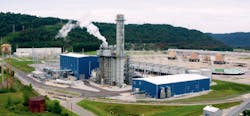Even though wind and solar have been making gains for years, the sustainability flavor of the decade so far is hydrogen. This is because it promises to be one of the best ways to store power generated by the other two sources, and can also be blended with natural gas to improve its sustainability.
To explore and develop hydrogen’s potential, Long Ridge Energy (LRE) in Hannibal, Ohio, recently developed what it reports is the world’s first, purpose-built, utility-scale, combined-cycle hydrogen power plant. The 485-megawatt (MW) plant began operations on natural gas, but transitioned by early 2022 to begin blending hydrogen into the natural gas fuel it burns to produce electricity, and prove the viability of using carbon-free, renewable hydrogen as a feedstock for cleaner power generation.
However, blending hydrogen with natural gas increases the potential risk of fire, explosion and environmental impact, so LRE had to mitigate those risks. It also needed to reduce waste, increase efficiency, and make its product eco-friendly. These goals required strict cofiring requirements, such as implementing an accurate hydrogen-injection system with blend validation, scaling operations easily and efficiently, smart measurement technology, and safety assurances.
Consequently, LRE completed four tests of injecting and controlling 5% blends of hydrogen. It obtained the gas from a local chemical manufacturer’s byproduct and consulted with Endress+Hauser about providing measurement instrumentation that could safely control the sensitive hydrogen/natural gas blend. The plant was fitted with a Coriolis flowmeter, Raman analyzer to measure and validate hydrogen blending, and a main-line flowmeter downstream of the hydrogen injection point.
Flowmeters, analyzers for careful blending
The Proline Promass Q Coriolis flowmeter is used at the injection point to allow blending into the fuel system, and enable setting the injection rate within an error band of 0.25% without needing restrictive, straight-run piping upstream or downstream. Downstream of the injection point, a Proline Promass F Coriolis flowmeter was installed to monitor main-line gas flow. Flowrates are used to determine the correct hydrogen injection rate into the natural gas system, but monitoring the blend’s percentage concentration helps validate its safety and performance optimization. Both Endress+Hauser flowmeters at LRE are employed in accordance with EPA fuel-flow standards for calculating emissions, including adjusted emissions after introducing hydrogen.
In addition, LRE added Endress+Hauser’s Raman Rxn5 spectroscopy-based analyzer to perform blend validation to mitigate the consequences of an off-balance gas blend, especially one with a high hydrogen content. The analyzer performs real-time composition analysis of rapidly changing gas turbine fuels blended with hydrogen. This analyzer was also paired with a Raman Rxn-30 probe that only needs 15 seconds to conduct an accurate measurement directly in the gas stream. Together, the two analyzers provide calculations of the Wobbe index, which is a reference that compares the energy output of different gas blends, and is critical when using alternative fuel sources like hydrogen that has fewer BTUs per volume than natural gas.
“Unlike gas chromatography (GC) that takes samples and requires users to wait for six to 10 minutes, Raman can measure compositions in just a few seconds, which allows users to respond and improve their process in ways they couldn’t do before,” says Cesar Martinez, marketing manager for natural gas, carbon capture, blue hydrogen and LNG industry at Endress+Hauser. “In this case, sustainability comes from greener energy sources and what they can add to the value chain. The U.S. has many upstream power sources, so its goal is exporting natural gas, lithium and other commodities.”
In the future, LRE reports its injection-line capacity can be easily expanded using a higher-capacity Proline Promass X Coriolis flowmeter with minimal piping modifications. Likewise, Raman Rxn5 analyzer can be tailored to meet specific fuel needs and handle a variety of fuel blends without changing components. This flexibility will enable LRE’s expansion as it migrates from its present 5% demonstration blends to production ratios of 20% or greater, where the velocity of the gas can exceed limitations of flowmeter optimized for natural gas.
Following its installation at LRE, Endress+Hauser developed a preassembled, hydrogen blending skid, to prepare for wider rollouts of hydrogen in natural gas-fuel pipelines and systems.
About the Author

Leaders relevant to this article:

